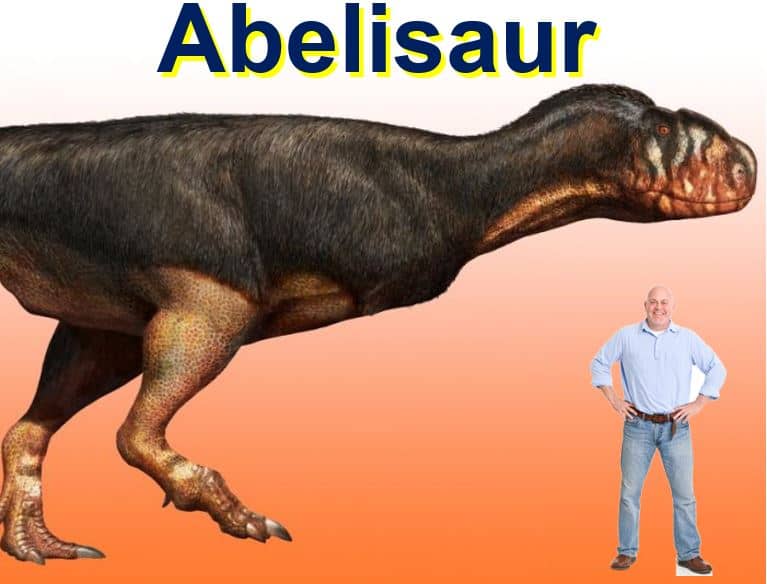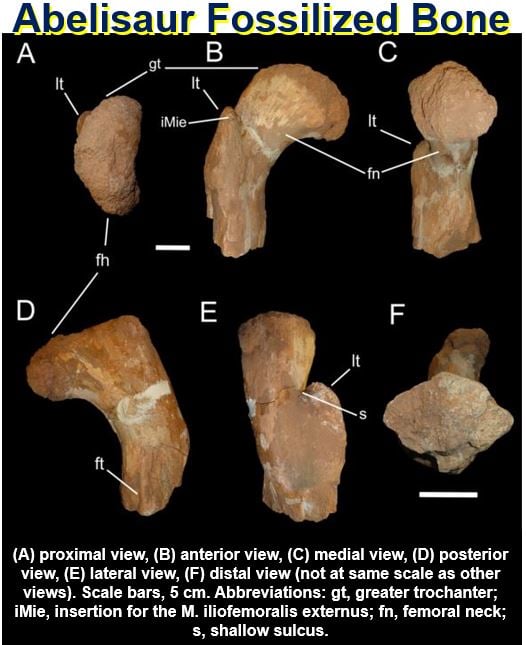Abelisaur was a gigantic carnivorous dinosaur nine metres (29.5 ft) long that weighed from 1 to 2 tonnes and existed about 95 million years ago, during the late Cretaceous period. It would have been a bizarre-looking creature, because it was also covered all over in fluffy feathers.
An unidentified fossilised bone in a museum has helped Alessandro Chiarenza, a PhD student from Imperial College London, determine how big the fearsome abelisaur was, thus solving a century-long puzzle.
Details of this latest study and its findings have been published in the scientific journal Peer J (citation below).
 Abelisaur was a massive predatory carnivorous dinosaur. Don’t be fooled by its ultra-tiny front limbs – it was a fearsome creature. (Image: Imperial College London)
Abelisaur was a massive predatory carnivorous dinosaur. Don’t be fooled by its ultra-tiny front limbs – it was a fearsome creature. (Image: Imperial College London)
A long-forgotten femur helped solve a puzzle
Last year, Mr. Chiarenza saw a fossilised femur bone (thigh bone) that had been left, forgotten in a draw during his visit to the Museum of Geology and Palaeontology in Palermo, Sicily, Italy.
Together with Andrea Cau, a researcher from the University of Bologna, they got permission from the museum to examine and analyse the thigh bone.
They soon found out that the fossilised bone was from an abelisaur, a large, predatory, carnivorous dinosaur that flourished in the Southern hemisphere during the Cretaceous period.
Abelisaurs had tiny forelimbs, a short deep face, small and extremely sharp teeth, and very powerful, muscular hind limbs. They were also covered in fluffy feathers.
Africa was different then
The bone examined in this study would have come from an animal that lived in North Africa, which 95 million years ago was a lush savannah full of crisscrossing rivers and mangrove swamps.
 A thigh bone can tell us a lot about an extinct animal’s size. (Image: peerj.com)
A thigh bone can tell us a lot about an extinct animal’s size. (Image: peerj.com)
This prehistoric tropical world would have been an ideal habitat for the abelisaur, which would have hunted aquatic animals like crocodiles, large fish, turtles, as well as other dinosaurs.
By analyzing the bone, Chiarenza and Cau deduced that the dinosaur was probably about 9 metres long and weighed between one and two tonnes, making it potentially one of the biggest abelisaurs ever discovered.
The findings of this study are helping scientists determine the maximum sizes that these animals may have reached during their peak.
Abelisaurs had become massive beasts
Mr. Chiarenza said:
“Smaller abelisaur fossils have been previously found by palaeontologists, but this find shows how truly huge these flesh eating predators had become.”
“Their appearance may have looked a bit odd as they were probably covered in feathers with tiny, useless forelimbs, but make no mistake they were fearsome killers in their time.”
The fossilised femur came from a sedimentary outcrop in Morocco called the Kem Kem Beds, where several specimens from huge predatory dinosaurs have been unearthed.
 Alessandro Chiarenza (left) and Andrea Cau.
Alessandro Chiarenza (left) and Andrea Cau.
The phenomenon is known as Stromer’s Riddle, – how so many top predator species could have coexisted in the same terrain – in honour of Ernst Stromer (1871-1952), a German palaeontologist who first wrote about this abundance in 1912.
Since then, researchers have still been wondering how so many predatory dinosaurs – abelisaurs and five other groupings – could have lived side-by-side in this region simultaneously, without killing each other off.
Perhaps they did not coexist
Now, Chiarenza and Cau believe that these predatory dinosaur groups might not have co-existed so closely together. Perhaps the harsh and changing geology of the area mixed the fossil fragment records together, destroying the chronological ordering in the Kem Kem beds.
 The Kem Kem Beds, where the abelisaur femur was discovered, is a geological formation along the border between Morocco and Algeria in southeastern Morocco. It has fossilised remains of several top predatory dinosaurs. (Image: english.fossiel.net)
The Kem Kem Beds, where the abelisaur femur was discovered, is a geological formation along the border between Morocco and Algeria in southeastern Morocco. It has fossilised remains of several top predatory dinosaurs. (Image: english.fossiel.net)
This mixing up would have given us the illusion that several predatory groupings, including abelisaurs, shared the same terrain at the same time.
Similar studies of fossil beds in Tunisia have shown that animals like abelisaurs were inland hunters, while other predators such as the fish-eating spinosaurs probably lived near mangroves and rivers.
Mr. Chiarenza added:
“This fossil find, along with the accumulated wealth of previous studies, is helping to solve the question of whether abelisaurs may have co-existed with a range of other predators in the same region.”
“Rather than sharing the same environment, which the jumbled up fossil records may be leading us to believe, we think these creatures probably lived far away from one another in different types of environments.”
Thigh bone tells us much about an animal
Femora fossils are useful for researchers to study because they help them determine the overall size of the animal. This is because the femora are attached to the tail muscles and the thigh and have scars or bumps, which tell scientists where the muscles and ligaments were attached to the bone, and how large those ligament and muscles would have been.
Mr. Cau, a PhD Student in the Department of Biological Geological and Environmental Sciences, University of Bologna, said:
“While palaeontologists usually venture to remote and inaccessible locations, like the deserts of Mongolia or the Badlands of Montana, our study shows how museums still play an important role in preserving specimens of primary scientific value, in which sometimes the most unexpected surprises can be discovered.”
“As Stephen Gould, an influential palaeontologist and evolutionary biologist, once said, sometimes the greatest discoveries are made in museum drawers.”
The authors say they plan to look for more complete remains from the predatory dinosaurs in order to better understand their environment and evolutionary history.
Citation: “A large abelisaurid (Dinosauria, Theropoda) from Morocco and comments on the Cenomanian theropods from North Africa,” Alfio Alessandro Chiarenza & Andrea Cau. Peer J. DOI: org/10.7717/peerj.1754. 29 February, 2016.
